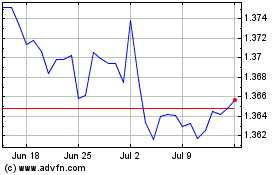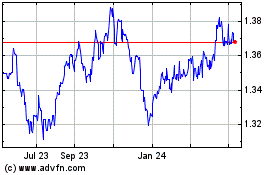Loonie Extends Decline After Disappointing Canadian Jobs Data
February 09 2018 - 5:01AM
RTTF2
The Canadian dollar continued to be lower against its major
counterparts in European trading on Friday, as the economy
unexpectedly shed jobs in January, while jobless rate rose.
Data from Statistics Canada showed that the economy lost 88,000
jobs in January.
This follows an addition of 64,800 jobs in December and
contradicts expectations for an increase of 10,000 jobs.
The unemployment rate increased to 5.9 percent from a revised
5.8 percent.
Economists were looking for a rate of 5.8 percent.
Oil prices slipped amid a stronger U.S. dollar and robust U.S.
production.
Crude for March delivery dropped $0.72 to $60.43 per barrel.
The loonie showed mixed trading against its major opponents in
the Asian session. While it held steady against the greenback, it
rose against the yen and the aussie. Against the euro, it
dropped.
Continuing early fall, the loonie hit a 4-day low of 0.9902
against the aussie, from more than a 4-week high of 0.9783 hit at
9:00 pm ET. The next likely support for the loonie is seen around
the 1.00 level.
Data from the Australian Bureau of Statistics showed that
Australia home loans fell a seasonally adjusted 2.3 percent on
month in December, coming in at 55,161.
That missed forecasts for a decline of 1.0 percent following the
2.1 percent increase in November.
The loonie extended slide to a 3-day low of 1.5559 against the
euro, compared to 1.5432 hit late New York Thursday. The next
likely downside target for the loonie is seen around the 1.57
level.
The loonie extended drop to a 1-1/2-month low of 1.2682 against
the greenback, from an early high of 1.2585. If the loonie falls
further, it may find support around the 1.28 mark.
The loonie fell further to 85.80 versus the yen, its lowest
since August 2017. This may be compared to a high of 86.77 hit at
3:45 am ET. The pair closed Thursday's deals at 86.28. The loonie
is seen finding support around the 84.00 area.
Data from the Ministry of Economy, Trade and Industry showed
that Japan's tertiary activity index decreased unexpectedly at the
end of the year, though slightly.
The tertiary activity index dropped 0.2 percent month-over-month
in December, reversing a 1.1 percent rise in November. Meanwhile,
economists had expected a 0.2 percent increase for the month.
US Dollar vs CAD (FX:USDCAD)
Forex Chart
From Mar 2024 to Apr 2024

US Dollar vs CAD (FX:USDCAD)
Forex Chart
From Apr 2023 to Apr 2024
